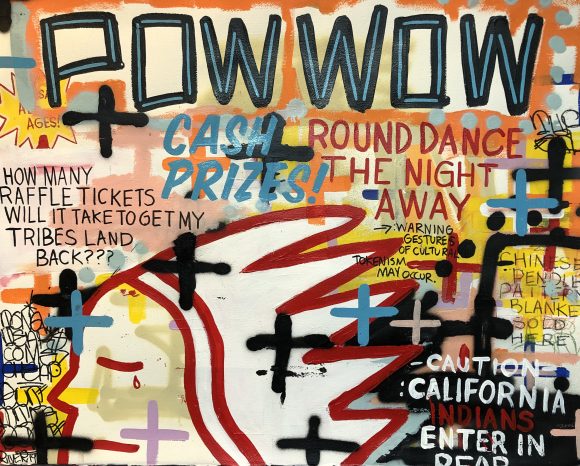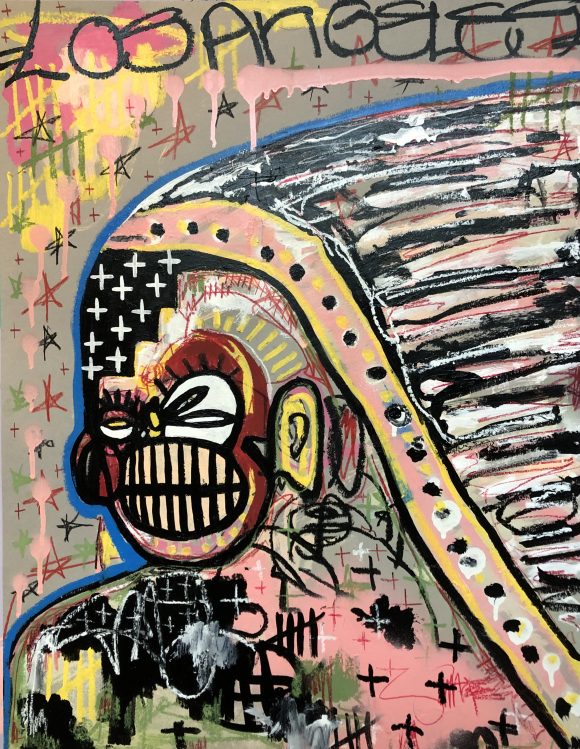River Garza Expressing the Intersectionality of Identities through Visual Imagery
September 14, 2022
Earlier this summer, the Escalette Collection introduced Mercedes Dorame, an artist whose work asserts the Tongva people’s presence by intervening in the landscapes of California. Today, we’d like to introduce another Tongva artist who utilizes visual imagery to amplify the voices of Indigenous peoples in Los Angeles: River Garza. River Garza is a Los Angeles-based artist who “draws on traditional Indigenous aesthetics, Southern California Indigenous maritime culture, skateboarding, graffiti, Mexican culture, and Low Rider culture.” In 2021, Mercedes and River worked together with Cara Romero and several other Native American artists on Tongvaland, a project “dedicated to the empowerment, recognition and social justice for Tongva Indian peoples.” Between August and September, artworks by each artist were installed on billboards around Los Angeles to assert “We are still here.” This installation sought to raise awareness of the Native American communities still living in Los Angeles and to assert that Tongva must be centered in discussions about the past, present, and future of Los Angeles.
River Garza was born in 1994 and raised in Gardena, California. As an artist of Indigenous and Mexican descent, he developed a close relationship with the land known as Los Angeles. Growing up within his tribal community, the Ti’at Society (named after the Tongva canoes used to navigate the Southern California coast and the Channel Islands), he was exposed to traditional maritime customs and ancestral beliefs since birth. Garza credits his aunt Cindi Alvitre for grounding him in his culture from a young age. The art he makes is “an extension of what [his] family and tribal community have done since time immemorial” and embraces the creative spirit of his ancestors.
“I am an amalgamation of centuries of resistance, forced assimilation, and resettlement and my work reflects those disjointments of memory, tradition, and identity” – River Garza
Garza’s artistic practice is inseparable from his Tongva heritage. He approaches artmaking as an expression of identity, specifically the intersection of his Tongva and Mexican heritages. For Garza, this form of expression critiques settler capitalism, challenging the Indian mystique and disrupting the cultural clichés of Hollywood’s “celluloid Indian.” In place of these stereotypes, Garza explores the complexity of the modern Indigenous experience through literal and metaphorical layers. Pow wow round 2, in particular, incorporates a Native American silhouette that resembles several consumer product and sports logos. This appropriated image is surrounded by – and embedded into – layers of text and patters that indicate a colonial past while celebrating ancestral Tongva iconography. The phrases that dance throughout the composition, like “Cash Prizes!” and “How Many Raffle Tickets Will It Take to Get My Tribes Land Back???” offer a critique of the commodification of Native American culture in American society. The physical layering of oil, spray, paint, pen in both Pow wow round 2 and The Angelino reflects the rich and complex culture of the Tongva people, rejecting these static representations.

River Garza, Pow wow round 2, acrylic, marker, spray paint, color pencil, and enamel on paper, 2019.
Ultimately, the notion of visual sovereignty is at the heart of Garza’s artistic practice. Due to his tribe’s lack of access to their traditional land base, he is drawn to projects that are temporally and spatially tied to locations of Tongva ancestral land, creating sites that provide “an imagined future where the Tongva people can exercise their full right as the original peoples of this land.” Despite the fact that the Tongva people’s primary mode of communication is their oral language, Garza implements the Western conventions of written language to invite broader audiences to be part of the conversation. He utilizes wordplay and visual imagery simultaneously to convey parts of their language and culture that are unfamiliar to most, opening the door to intersectional conversations. His artwork conveys the weight of his contemporary Indigenous identity, providing another powerful voice to his community of less than 2,000 remaining Tongvan descendants.
Sources:
https://www.rivergarza.com/about
https://www.youtube.com/watch?v=nqyOOxtXrQM
https://indiancountrytoday.com/news/art-installations-remind-la-residents-theyre-on-tongvaland
https://fowler.ucla.edu/events/a-global-destination-for-art-mercedes-dorame-and-river-garza/
We invite you to explore all the works in the Escalette Collection by visiting our eMuseum.
Wilkinson College of Arts, Humanities, and Social Sciences is the proud home of the Phyllis and Ross Escalette Permanent Collection of Art. The Escalette Collection exists to inspire critical thinking, foster interdisciplinary discovery, and strengthen bonds with the community. Beyond its role in curating art in public spaces, the Escalette is a learning laboratory that offers diverse opportunities for student and engagement and research, and involvement with the wider community. The collection is free and open to the public to view.



